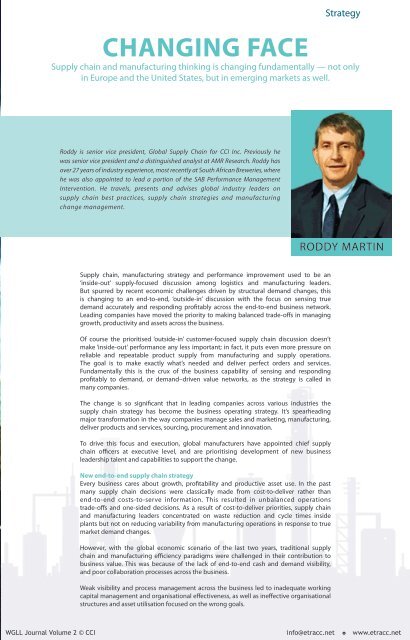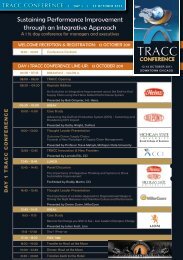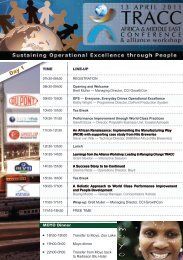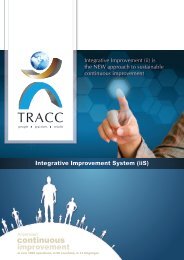Strategy - TRACC
Strategy - TRACC
Strategy - TRACC
You also want an ePaper? Increase the reach of your titles
YUMPU automatically turns print PDFs into web optimized ePapers that Google loves.
<strong>Strategy</strong><br />
CHANGING FACE<br />
Supply chain and manufacturing thinking is changing fundamentally — not only<br />
in Europe and the United States, but in emerging markets as well.<br />
Roddy is senior vice president, Global Supply Chain for CCI Inc. Previously he<br />
was senior vice president and a distinguished analyst at AMR Research. Roddy has<br />
over 27 years of industry experience, most recently at South African Breweries, where<br />
he was also appointed to lead a portion of the SAB Performance Management<br />
Intervention. He travels, presents and advises global industry leaders on<br />
supply chain best practices, supply chain strategies and manufacturing<br />
change management.<br />
RODDY MARTIN<br />
Supply chain, manufacturing strategy and performance improvement used to be an<br />
‘inside-out’ supply-focused discussion among logistics and manufacturing leaders.<br />
But spurred by recent economic challenges driven by structural demand changes, this<br />
is changing to an end-to-end, ‘outside-in’ discussion with the focus on sensing true<br />
demand accurately and responding profitably across the end-to-end business network.<br />
Leading companies have moved the priority to making balanced trade-offs in managing<br />
growth, productivity and assets across the business.<br />
Of course the prioritised ‘outside-in’ customer-focused supply chain discussion doesn’t<br />
make ‘inside-out’ performance any less important; in fact, it puts even more pressure on<br />
reliable and repeatable product supply from manufacturing and supply operations.<br />
The goal is to make exactly what’s needed and deliver perfect orders and services.<br />
Fundamentally this is the crux of the business capability of sensing and responding<br />
profitably to demand, or demand–driven value networks, as the strategy is called in<br />
many companies.<br />
The change is so significant that in leading companies across various industries the<br />
supply chain strategy has become the business operating strategy. It’s spearheading<br />
major transformation in the way companies manage sales and marketing, manufacturing,<br />
deliver products and services, sourcing, procurement and innovation.<br />
To drive this focus and execution, global manufacturers have appointed chief supply<br />
chain officers at executive level, and are prioritising development of new business<br />
leadership talent and capabilities to support the change.<br />
New end-to-end supply chain strategy<br />
Every business cares about growth, profitability and productive asset use. In the past<br />
many supply chain decisions were classically made from cost-to-deliver rather than<br />
end-to-end costs-to-serve information. This resulted in unbalanced operations<br />
trade-offs and one-sided decisions. As a result of cost-to-deliver priorities, supply chain<br />
and manufacturing leaders concentrated on waste reduction and cycle times inside<br />
plants but not on reducing variability from manufacturing operations in response to true<br />
market demand changes.<br />
However, with the global economic scenario of the last two years, traditional supply<br />
chain and manufacturing efficiency paradigms were challenged in their contribution to<br />
business value. This was because of the lack of end-to-end cash and demand visibility,<br />
and poor collaboration processes across the business.<br />
Weak visibility and process management across the business led to inadequate working<br />
capital management and organisational effectiveness, as well as ineffective organisational<br />
structures and asset utilisation focused on the wrong goals.<br />
WGLL Journal Volume 2 © CCI info@etracc.net www.etracc.net

















